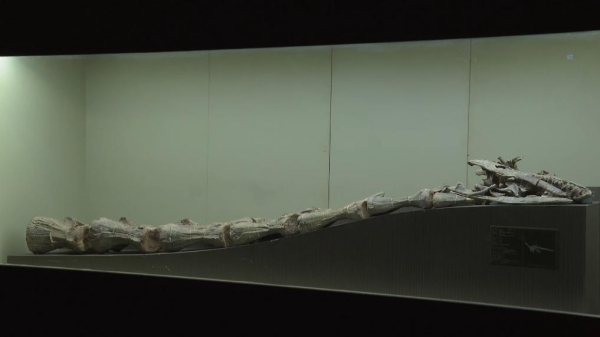
Photo: Xinhua News Agency
A new genus and species of non-sauropodan sauropodomorph, the
Lishulong wangi gen. et sp. nov., has been identified from a fossil discovered in the Lower Jurassic Lufeng Formation, in Southwest China's Yunnan Province.
"
Lishulong wangi possesses the largest cranial material among its group in the Lufeng Formation, measuring about 40 centimeters in length. Its discovery has increased the diversity of dinosaurs in Southwest China and enhanced our understanding of the evolutionary characteristics of early-diverging sauropodomorphs," lead researcher You Hailu from the Chinese Academy of Sciences' Institute of Vertebrate Paleontology and Paleoanthropology told the Global Times on Monday.
This new species indicates that sauropodomorph dinosaurs experienced rapid expansion and maintained a sustained diversity advantage in China during the Early Jurassic period, he added.
The findings, derived from a collaborative effort between the institute and the Bureau of Natural Resources of Lufeng County, have been published recently in the journal PeerJ journal under the title The largest sauropodomorph skull from the Lower Jurassic Lufeng Formation of China. .
According to the research team, studying dinosaur fossils is a long-term and complex process. It often takes several years to go from excavation, repair and assembly to producing scientific results.
The fossil, unearthed in 2007 during a scientific survey in Dalishu village, Lufeng, includes a relatively complete skull and nine cervical vertebrae. In 2008, after undergoing repair and assembly, the fossil was sent to the museum of Lufeng World Dinosaur Valley for display.
"During the excavation, the posterior part of the specimen was washed away by rainwater in a gully. Only the skull and cervical vertebrae were relatively well-preserved," said Wang Tao, director of the Dinosaur Fossil Protection and Research Center at the Bureau of Natural Resources of Lufeng County.
"Based on the existing fossil remains, the dinosaur is estimated to have measured around 8 meters in length when alive," Wang added.
According to the thesis, the fossilized skull is relatively large with thin vertically supportive bones. It seems to have undergone severe transverse compression, resulting in the distortion of its dorsal and palatal elements.
However, the two lateral sides of the skull are essentially intact, except for some missing bones in the orbital and temporal regions, such as the postorbital, jugal, quadratojugal and squamosal, which were displaced from their original position or even lost.
The skull is low and elongated in lateral view with an anteroposterior length of 40 centimeters, making it the largest cranial material recovered from the Lufeng Formation, while the previously largest is the skull of Jingshanosaurus, which is about 35 centimeters long, said the paper.
To date, a total of six genera and eight species of Early Jurassic sauropodomorphs have been identified in Lufeng. "Through morphological comparisons combined with the phylogenetic analysis, we showed that the specimen of
Lishulong wangi cannot be classified into any previously discovered genera," You said.
However, phylogenetic analyses reveal that Lishulong is an early-diverging member of the Sauropodiformes, and the sister-taxon of
Yunnanosaurus.
Based on the current fossil records,
Lishulong wangi is the largest sauropodomorph from the Early Jurassic epoch in China, and is considered morphologically mature according to the paper.
"The limited paleobiogeographic information available from Lishulong provides evidence that at least the initial sauropodiform lineages that are closely related to near-Sauropoda or Sauropoda existed in southwestern China during the Early Jurassic epoch," noted You.




